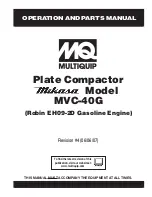
MVC-40G PLATE COMPACTOR — OPERATION & PARTS MANUAL — REV. #4 (06/06/07) — PAGE 15
MVC-40G — INSPECTION
Before Starting
1. Read safety instructions at the beginning of manual.
2. Clean the compactor, removing dirt and dust. Particularly, the
bottom of the plate, engine cooling air inlet, carburetor and
air cleaner.
3.
Check the air filter for dirt and dust. If the air filter is dirty, blow
through the air filter cartridge from the inside, moving a jet of
dry compressed air up and down until all dust is removed.
Otherwise replace air filter with a new one.
4. Check carburetor for external dirt and dust. Clean with dry
compressed air.
5.
Check fastening nuts and bolts for tightness. Loosened
screws or bolts due to vibration, could lead to unexpected
accident.
Engine Oil Check
1. To check the engine oil level, place the plate compactor on
secure level ground with the engine stopped.
2. Remove the filler cap/dipstick from the engine oil filler hole
(Figure 5) and wipe it clean.
Figure 5. Engine Oil Dipstick
3. Insert and remove the dipstick without screwing it into the filler
neck. Check the oil level shown on the dipstick.
4. If the oil level is low (Figure 6), fill to the edge of the oil filler
hole with the recommended oil type (Table 4).
Figure 6. Engine Oil Dipstick
The Oil Alert system will
automatically shut-down the
engine if the engine oil level falls
below safe operating limits.
Always be sure to check the
engine oil level prior to starting
the engine.
UPPER LIMIT
LOWER LIMIT
NOTE
Fuel Check
1. Remove the gasoline cap located on top of fuel tank.
2. Visually inspect to see if fuel level is low. If fuel is low,
replenish with unleaded fuel.
3. When refueling, be sure to use a strainer for filtration.
DO
NOT
top-off fuel. Wipe up any spilled fuel.
Motor fuels are highly flammable and can
be dangerous if mishandled.
DO NOT
smoke while refueling.
DO NOT
attempt to
refuel the compactor if the engine is
hot!
,
running or in the dark
.
Danger - Flammable Fuel
Adding fuel to the tank should be done only
when the engine is stopped and has had an
opportunity to cool down. In the event of a fuel
spill,
DO NOT
attempt to start the engine until
the fuel residue has been completely wiped
up, and the area surrounding the engine is
dry.
Danger - Flammable Fuel
e
p
y
T
li
O
.
4
e
l
b
a
T
n
o
s
a
e
S
e
r
u
t
a
r
e
p
m
e
T
e
p
y
T
li
O
r
e
m
m
u
S
r
e
h
g
i
H
r
o
C
°
5
2
0
3
-
W
0
1
E
A
S
ll
a
F
/
g
n
i
r
p
S
C
°
0
1
~
C
°
5
2
0
2
/
0
3
-
W
0
1
E
A
S
r
e
t
n
i
W
r
e
w
o
L
r
o
C
°
0
0
1
-
W
0
1
E
A
S

































